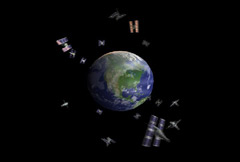Do you know where you are? - The
Global Positioning System |
 |
 |
 |
 |
|
|
The Global Positioning System (GPS) is
a constellation of
satellites orbiting
the Earth approximately
11,000 miles in space. Click on
the image for an animated view.
|
 |
|
Using the Global Positioning System (GPS), every
point on Earth can be given its own unique address
-- its latitude, longitude, and height. The U.S.
Department of Defense developed GPS satellites as
a strategic system in 1978. But now, anyone can gather
data from them. For instance, many new cars have
a GPS receiver built into them. These receivers help
drivers know exactly where they are, and can help
them from getting lost.
GPS is a constellation of satellites
that orbit approximately 11,000 miles above the
Earth and transmit radio wave signals to receivers
across the planet. By determining the time that it
takes for a GPS satellite signal to reach your receiver,
you can calculate your distance to the satellite
and figure out your exact location on the Earth.
Sound easy? In fact it is a very complicated process.
For the GPS system to work, you need to have incredibly
precise clocks on the satellites and receivers, and
you must be able to access and interpret the signals
from several orbiting satellites simultaneously.
Fortunately, the receivers take care of all the calculations.
Let's tackle the distance calculation first. GPS satellites have very precise clocks that tell time to within 40 nanoseconds or 40 billionths (0.000000040) of a second. There are also clocks in the GPS receivers. Radio wave signals from the satellites travel at 186,000 miles per second. To find the distance from a satellite to a receiver, use the following equation: (186,000 mi/sec) x (signal travel time in seconds) = Distance of the satellite to the receiver in miles.
 |
|
|
It takes four GPS satellites to calculate
a precise location
on the Earth using
the Global Positioning
System. Click
on the image for larger
view. |
 |
|
Knowing the distance of your GPS receiver to a single satellite is useful, but it will not provide you with enough information to determine your exact position on the Earth. For that, you need to simultaneously access the signals from four satellites. By calculating its distance from three satellites simultaneously, a GPS receiver can determine its general position with respect to latitude, longitude, and elevation.
You may wonder why the GPS receiver needs a fourth satellite. Essentially, it provides for even greater precision. To accurately calculate the distance from the GPS receiver to each of the three orbiting satellites, you must know the precise radio signal transmission and reception times. To do this, the clocks in the satellites and the clocks in the receivers must be perfectly synchronized. A mismatch of as little as one millionth of a second between the clock in the satellite and the clock in the receiver could translate into a positioning error of as much as 900 feet (Herring). The atomic clocks in the satellites are extremely accurate, but the clocks in the GPS receivers are not, which creates a timing error. The signal from the fourth satellite is used to adjust for the receiver clock error and calculate the receiver's correct position. So, the receiver needs at least four satellite signals to calculate a position. But if the receiver can access more satellite signals, it will calculate a more accurate position (Tinambunan).
(top)

